 The Socialist Republic of the Union of Myanmar Paper Money Collection
The Socialist Republic of the Union of Myanmar Paper Money Collection
© Copyright 1995-2009, Clay Irving <clay@panix.com>, Manhattan Beach, CA
The Socialist Republic of the Union of Myanmar Notes
On 02 March 1962, General Ne Win overthrew the government of the Union of Burma, suspended the constitution, installed himself as chief of state, and pursued a socialistic program with nationalization of nearly all industries and trade. On 04 January 1974, a new constitution adopted by referendum established Burma as a "socialistic republic" under one-party rule, and the country name was officially changed to the Union of Myanmar.
On 03 November 1985, the 25, 50, and 100 Kyat notes were demonetized without warning, though the public was allowed to exchange limited amounts of the old notes for new ones. All other denominations then in circulation remained legal tender.
On 10 November 1985, 75 Kyat notes were introduced, the odd denomination possibly chosen because of dictator Ne Win's predilection for numerology; the 75 Kyat note was supposedly introduced to commemorate his 75th birthday. It was followed by the introduction of 15 and 35 Kyat notes on August 1, 1986.
On 05 September 1987, Burma's ruler general Ne Win suddenly demonitized the 25, 35, and 75 Kyat note which caused a great down fall in the economy. The main reason of General Ne Win to cancel these notes was superstition, as he considered the number nine his lucky number; so he only allowed 45 and 90 kyat notes, because these were divisible by nine. Burma's admittance to Least Developed Country status by the UN the following December highlighted its economic bankruptcy.
Following the change of the country's name to Myanmar on 20 June 1989, new notes began to be issued. This time, the old notes were not demonetized, but simply allowed to fall into disuse through inflation as well as wear and tear. On 01 March 1990, 1 Kyat notes were issued, followed by 200 Kyat notes on 27 March 1990. On 27 March 1994, notes for 50 pya, 20, 50, 100, and 500 kyats were issued, followed, on 01 May 1995, by new 5 and 10 Kyat notes. 1,000 Kyat notes were introduced in November 1998.
For earlier issues refer to The Socialist Republic of the Union of Burma.
|
[ Last Update: Sunday, 14-Feb-2010 14:08:01 EST ]
|
Central Bank of Myanmar |
1990 ND Issue |
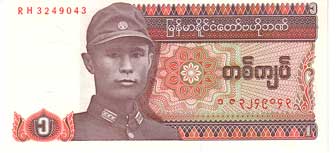 | P67 - 1 Kyat
Front: General Aung San at left
Back: Dragon carving at left
Watermark: General Aung San
Size: 130 x 62 mm |
|
1991-1998 ND Issue |
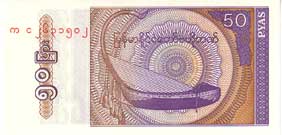 | P68 - 50 Pyas Note, 1994
1 Kyat = 100 Pyas
Front: Musical string instrument at center
Size: 110 x 55 mm |
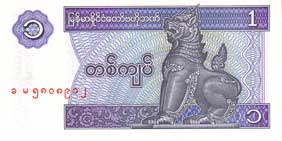 | P69 - 1 Kyat, 1996
Front: Chinthe at center right
Back: Rowing in river
Size: 110 x 55 mm
Chinthe
The Chinthe is a leogryph (lion-like creature) that revered and loved by the Burmese people. It is often seen in pairs at the entrances of pagodas and temples in Burma and other Southeast Asian countries. The chinthe is used symbolically on the royal thrones of Burma, and is featured prominently on the kyat. The story of the Chinthe goes something like this: A princess had a son through her marriage to a lion, but later abandoned the lion who then became enraged and set out on a road of terror throughout the lands. The son then went out to slay this terrorizing lion. The son came back home to his mother stating he slew the lion, and then found out that he killed his own father. The son later constructed a statue of the lion as a guardian of a temple to atone for his sin. |
|
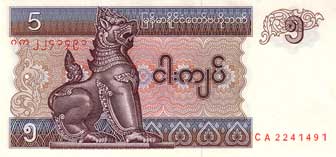 | P70b - 5 Kyats, 1997
Front: Chinthe at center left
Back: Ball game sceen
Watermark: Chinthe bust over value of note
Size: 131 x 62 mm |
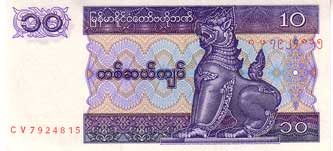 | P71b - 10 Kyats, 1997
Front: Chinthe at center left
Back: Elaborate barge
Watermark: Chinthe bust over value of note
Size: 130 x 62 mm |
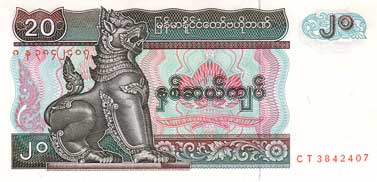 | P72 - 20 Kyats Note, 1994
Front: Chinthe at center left
Back: Elephant fountain right center
Watermark: Chinthe bust over value of note
Size: 147 x 70 mm |
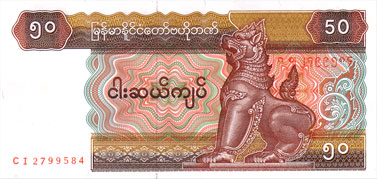 | P73 - 50 Kyats
Front: Chinthe at right
Back: Artisan making pottery
Watermark: Chinthe bust over value of note
Size: 147 x 70 mm |
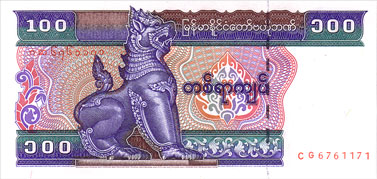 | P74 - 100 Kyats
Front: Chinthe at right
Back: Workers restoring temple and grounds at center
Watermark: Chinthe bust over value of note
Size: 147 x 70 mm |
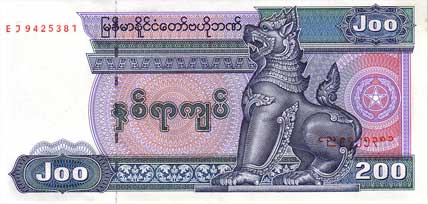 | P75 - 200 Kyats
Front: Chinthe at right
Back: Elephant pulling log at center right
Watermark: Chinthe bust over value of note
Size: 167 x 80 mm |
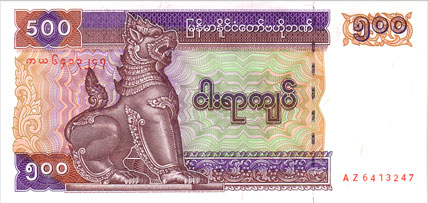 | P76 - 500 Kyats
Front: Chinthe at right
Back: Workers restoring statue, man hauling water, and craftsmen
Watermark: Chinthe bust over value of note
Size: 167 x 80 mm |
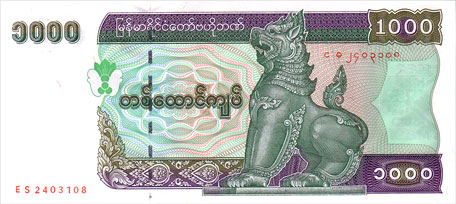 | P77 - 1000 Kyats
Front: Chinthe at right
Back: Central Bank building
Watermark: Chinthe bust over value of note
Size: 178 x 80 mm |
|
2004 ND Reduced Size Issue |
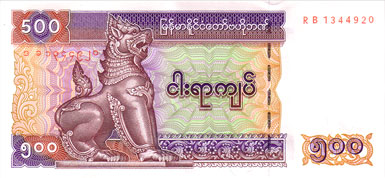 | P79 - 500 Kyats
Front: Chinthe at right
Back: Workers restoring statue, man hauling water, and craftsmen
Watermark: Chinthe bust over value of note
Size: 150 x 70 mm |
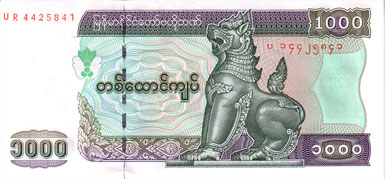 | P80 - 1000 Kyats
Front: Chinthe at right
Back: Central Bank building
Watermark: Chinthe bust over value of note
Size: 150 x 70 mm |
|
2009 ND Issue |
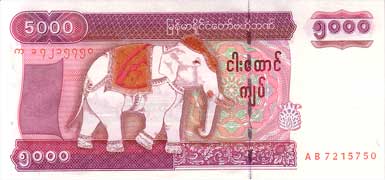 | P-NEW - 5000 Kyats
Front: Royal white elephant at center
Back: Hluttaw buildings (Peoples Assembly)
Watermark: White elephant
Size: 150 x 70 mmReleased into circulation on 01 October 2009, the 2009 5000 Kyat Note is the largest denomination note for Myanmar. |
 The Socialist Republic of the Union of Myanmar Paper Money Collection
The Socialist Republic of the Union of Myanmar Paper Money Collection The Socialist Republic of the Union of Myanmar Paper Money Collection
The Socialist Republic of the Union of Myanmar Paper Money Collection